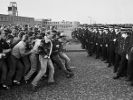Eye For Film >> Movies >> Dancing In Dulais (1986) Film Review
Dancing In Dulais
Reviewed by: Jennie Kermode

Recorded on video and not in great shape these days, this 25 minute documentary is nevertheless a fascinating record, and one that is likely to gain renewed fame now as the inspiration for hit film Pride. It's the story of the gay and lesbian activists from London whose work on behalf of the miners' community in Dulais during the strikes of the early Eighties brought two stigmatised groups together and reshaped left wing politics.
For most of the 20th Century, equality struggles were divided into two kinds: those that sought to give everyone equal status within society (regardless of sexuality, gender, race etc.) and those which sought to tackle economic disparities. Those involved with the former didn't expect to be welcomed by the latter, who, even when they didn't share popular prejudices, often saw them as a distraction. The decision by lesbian and gay activists to help the miners was therefore a bold one and, as it turned out, pivotal to a change in attitudes. Though it isn't articulated precisely here, those contributing to this film are clearly aware of this. Miners' wives talk about how, even if they weren't prejudiced, they didn't really give the struggles of gay and lesbian people more than a passing thought beforehand. Afterwards, they realised that what was happening to them - the social exclusion, the constant sense of being targeted by the police - had happened to lots of other groups, and that it would keep on doing so "unless we do something about it."

Dancing In Dulais is very much of its time. One can see here the drab clothes most people really wore in the Eighties, as opposed to the lurid ones that featured in TV programmes and have since been imagined into memory. It sometimes takes a moment to work out who's who because every woman has what would later come to be thought of as a lesbian haircut. Backgrounds are bright and geometric, projecting a sense of energy that the participants can't live up to, though they are by no means uninteresting. In scene transitions the image shrinks to a hexagon and then opens out again. We hear the dance music of the time and briefly see Jimmy Somerville of Bronski Beat (and later the Communards) performing at a benefit gig for the struggling miners.
Most of what they did was raise money, the activists say, because that was what they were good at. One woman talks about her group taking regular collections in several lesbian clubs. This may make tough viewing for LGBT people who spent the era outside London where there was never any money to fund groups and they would be lucky if they could find one club to go to, but there's no doubt that it was important in transforming the miners' circumstances. It stemmed in part from a realisation, we are told, that if the miners were defeated the Conservative government would target other groups next. In fact, it would be just two years after this film was introduced that the infamous Clause 28 did exactly that, effectively shutting down the kind of LGBT visibility in the arts that this film exemplifies.
Although the framework here is pretty simple - just a series of people, individually or in groups, talking to camera - it includes a wealth of historical detail that will make it fascinating to those interested in the social movements of the era. It's not great cinema but it is without doubt an important film.
Reviewed on: 20 Sep 2014















